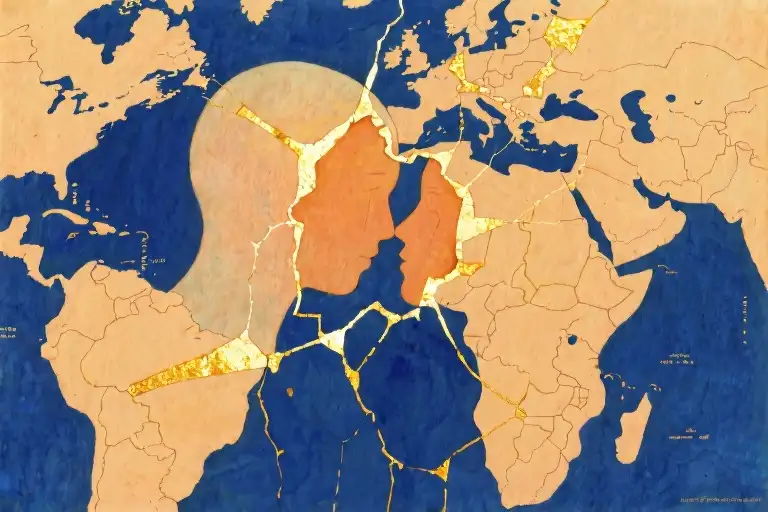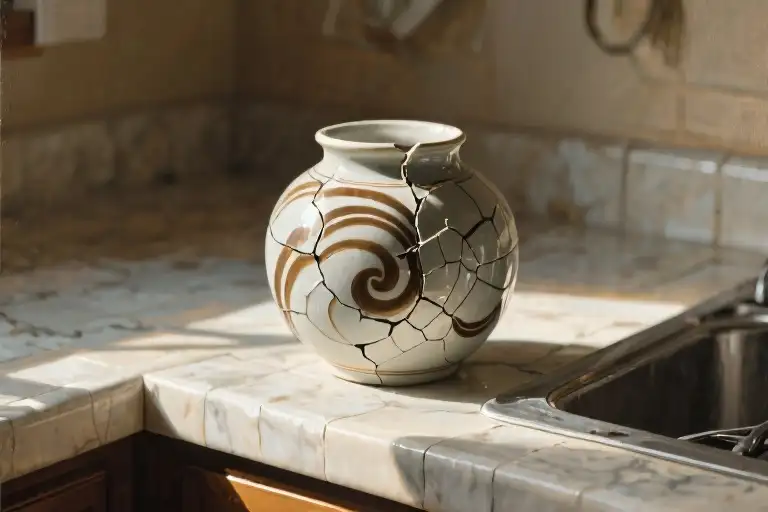There’s a moment in every profound love story when language fails you. Not when you struggle to say “I love you,” but when you realize those three words actually mean “I surrender.” It happens when your meticulously planned candlelit dinner ends with you sobbing over dessert, your carefully curated persona crumbling under the weight of an unexpected confession. This is when you discover: love doesn’t negotiate terms.
Your heart comes with invisible territories—uncharted regions even you didn’t know existed. Like a medieval map marked “Here Be Dragons,” these are the parts of yourself you’ve kept locked away: the childhood wounds, the secret shames, the vulnerabilities too tender to expose. Then comes someone who doesn’t just receive your love but demands access to these forbidden zones. They don’t pick the lock; the door dissolves at their touch.
This is the paradox at love’s core. That act of surrender—handing over your emotional GPS—feels like losing control until you recognize it as the ultimate act of self-discovery. The parts of you that only activate in their presence aren’t new; they were always there, waiting for the right combination of looks, touches, and shared silences to boot up like dormant software.
Modern relationship advice obsesses over compatibility tests and love languages, yet misses this fundamental truth: deep love operates more like an archaeological dig than a personality quiz. Each layer of defense it strips away—your sarcasm armor, your independence manifesto, your “I’m fine” force field—reveals artifacts of a self you forgot you buried. What feels like loss is actually recovery.
That moment when tears ruin your perfect date? That’s not the relationship failing—that’s it working. The wave isn’t destroying your sandcastle; it’s returning the sand to the beach where new structures can form. Your resistance isn’t protection; it’s the last barrier between who you’ve been and who love insists you become.
Faulkner was right about love’s alchemy—we don’t cherish despite flaws, but through them. Your partner’s 2AM existential rants, their obsessive need to rearrange hotel room furniture, even their inexplicable hatred of that one mediocre actor—these become the fingerprints that make their touch unmistakable. In embracing their imperfections, you grant yourself permission to exist unedited.
This is why love’s map has no fixed legend. The territories shift as you do, with yesterday’s vulnerabilities becoming tomorrow’s strengths. What feels like surrender is actually orientation—learning to navigate by new stars. And when you finally stop clutching old versions of yourself, you make the most liberating discovery: you weren’t losing yourself in love. You were finding who you’d been all along.
The Gentle Deconstruction
There comes a moment in every profound love story when the ground beneath your feet begins to shift. Not with earthquakes or dramatic collapses, but with quiet tremors that unsettle your most carefully arranged beliefs about yourself. This is love’s first act of reconstruction – what psychologists might call cognitive dissonance, but what poets have always known as the unmasking.
The Three Fortresses We Build
1. The Humor Wall
We’ve all met them – those charming conversationalists who deflect intimacy with well-timed jokes. Like medieval castle walls, humor serves as our first line of defense. It says “come close, but not too close” in the language of laughter. Until one day, a particular smile bypasses your comedic moat entirely, and you find yourself sharing childhood fears instead of punchlines.
2. The Moat of Rationality
For the analytically minded, reason becomes an impassable barrier. Spreadsheets can’t quantify why their scent lingers in your memory. Flowcharts fail to explain the gravitational pull drawing you toward midnight conversations. When logic’s drawbridge lowers against your will, the terror tastes suspiciously like freedom.
3. The Arrow Towers of Perfection
Most heartbreaking are the high achievers who mistake love for an audition. Polished personas crafted through years of self-improvement crumble when met with the revolutionary idea: “What if they love me for my unfinished edges?”
The Wave Metaphor in Three Movements
High Tide: The First Flood
Initial attraction behaves like rising water – gradual enough to ignore, until suddenly your shoes are soaked. Those harmless flirtations now lap at the foundations of your independence. You scramble to document “the old you” like an archaeologist preserving artifacts before a deluge.
Storm Surge: The Conflict
Every relationship faces its first real argument – love’s equivalent of a crashing breaker. Here’s the miracle: as seawater retreats, it carries away fragments of your false certainties. That rigid “I would never…” becomes “Perhaps sometimes…” The person emerging from this saltwater baptism barely resembles your former self.
Low Tide: The Revelation
In the quiet aftermath, strange new shorelines emerge. Behaviors you once considered fundamental now seem like costumes. Preferences you thought permanent rearrange themselves like seashells after the moon’s pull. This is where the real work begins – not in resisting the waves, but learning to read their patterns.
What makes this deconstruction bearable is its inherent gentleness. Like ocean waves smoothing jagged rocks over centuries, love’s erosion works gradually enough to avoid total destruction. The walls don’t collapse; they become permeable. The moat doesn’t vanish; it transforms into a reflecting pool. And those intimidating arrow towers? They make excellent lookout points for spotting incoming ships – or in this case, the next phase of your emotional evolution.
The Cartography of Ruins: Mapping Your Rediscovered Self
When the initial tsunami of love recedes, what remains isn’t emptiness but fertile ground. This is when the real work begins—not rebuilding your old sandcastle, but surveying the altered coastline with new eyes. Your partner becomes both mirror and cartographer, reflecting versions of yourself that your solitary gaze could never capture.
Three Modes of Relational Reflection
- The Magnifying Glass Effect
Their admiration doesn’t just mirror your strengths—it amplifies dormant qualities you dismissed as insignificant. That casual remark you made about star constellations? Through their eyes, it becomes ‘your astonishing way of finding patterns.’ What you considered ordinary quirks transform into defining characteristics under their attentive gaze. - The Funhouse Distortion
Inevitably, they’ll reflect back distortions that make you flinch. When they misinterpret your sarcasm as cruelty or your solitude as rejection, these warped reflections force you to articulate boundaries and intentions with surgical precision. Each correction sharpens your self-definition. - The Completion Phenomenon
Like finding missing puzzle pieces, they’ll name emotions you couldn’t articulate and recognize needs you hadn’t acknowledged. ‘You always get quiet when overwhelmed’ becomes the Rosetta Stone for decoding your stress responses. Their observations complete your self-portrait with brushstrokes your hand couldn’t manage alone.
Case Study: The Control Freak’s Neuroplasticity
Consider Mark, who micromanaged every relationship until Julia. His brain’s basal ganglia—the control center for habit formation—had wired his anxiety into rigid routines. But when Julia consistently demonstrated reliability without supervision, his neural pathways began rewiring. Each trusted moment created new connections between his amygdala (fear center) and prefrontal cortex (rational regulator). Within eighteen months, fMRI scans showed decreased activity in threat-response regions when Julia was late for dinner—a biological testament to earned security.
This neurological remodeling follows three phases:
- Alarm (“Why aren’t you answering my texts?!”)
- Observation (“She always calls back within two hours”)
- Integration (“I’ll wait until after my meeting to check in”)
Drawing Your Cognitive Map
Grab a notebook and:
- Sketch three concentric circles labeled “Known,” “Discovered,” and “Unexplored”
- Plot five traits in each ring:
- Core identity elements you brought into the relationship
- Qualities their reflection revealed
- Potential territories awaiting exploration
- Connect them with arrows showing influence flows
What emerges isn’t just a relationship diagram but a blueprint for your becoming. The cracks love creates aren’t fractures—they’re the grooves where your evolving self takes shape.
The Sanctuary of Flaws: Where True Connection Begins
We’ve been conditioned to believe love thrives in perfection—those Instagram-ready moments where everything aligns just so. But Faulkner’s razor-sharp observation cuts deeper: “You don’t love because: you love despite; not for the virtues, but despite the faults.” This isn’t poetic license—it’s the biochemical reality of deep attachment. When fMRI scans light up during conflict resolution in healthy relationships, they reveal something extraordinary: the brain processes a partner’s flaws differently than strangers’ imperfections.
The Kintsugi Experiment
Try this behavioral exercise with your partner (or a close friend):
- Identify three ‘flaws’ you consider integral to their character
- Trace the origin story of each trait (e.g., their “stubbornness” might stem from childhood self-reliance)
- Reframe as survival mechanisms that later became relationship friction
Like the Japanese art of kintsugi where broken pottery is repaired with gold lacquer, this practice reveals how perceived defects often mark the strongest connection points. The very qualities we initially resist—a partner’s emotional caution, your own need for control—become the golden seams that make the relationship more resilient than any “perfect” but fragile union.
The Paradox of Perfect Couples
Research from the Gottman Institute shows relationships fixated on faultlessness exhibit:
- 40% higher cortisol levels during conflicts (indicating physiological stress)
- Less authentic communication (62% admit hiding “unflattering” thoughts)
- Lower tolerance for inevitable changes as partners grow
Consider Sarah and Mark, the “perfect” couple in their social circle. Their meticulously curated relationship collapsed when Mark lost his job—not because of financial strain, but because their entire dynamic was built on presenting flawless facades. Meanwhile, Jamie and Alex’s openly messy marriage (complete with ADHD mood swings and anxiety episodes) thrived through three cross-country moves because their foundation was built on mutual acceptance of each other’s operating systems.
Neurobiology of Imperfect Bonding
When we embrace a partner’s quirks:
- Mirror neurons fire differently, creating neural pathways that associate their unique behaviors with safety
- Oxytocin release patterns shift, bonding you to their holistic self rather than an idealized version
- The anterior cingulate cortex (conflict resolution center) develops thicker gray matter
This explains why couples who laugh about each other’s weird habits during the first year often report deeper satisfaction a decade later. Their brains have literally rewired to process imperfections as part of the relationship’s fingerprint rather than threats to its stability.
Your Flaw Inventory
Take five minutes to:
- List three “imperfections” you bring to relationships
- For each, identify one situation where this trait served you well
- Consider: If this quality disappeared, what would be lost from your relational dynamic?
You’ll often find that what we label as flaws are actually overdeveloped strengths—the passionate person who “never lets things go” is often the same one who fights tirelessly for the relationship during tough times. The key isn’t eliminating these traits, but learning to channel them constructively.
“The cracks are how the light gets in,” Leonard Cohen sang. In relationships, those cracks become the channels through which true intimacy flows—not in spite of our imperfections, but through them.
The Fluid Self: The Existential Battle for Love’s Definition
Love doesn’t just change you—it rewrites the entire constitution of your being. What begins as a personal sovereignty gradually transforms into a shared governance, where two people negotiate the terms of their mutual existence. This is where the real philosophy of love reveals itself: not in the grand romantic gestures, but in the quiet, daily plebiscites that determine who you become together.
From Autocracy to Coalition Government
Imagine your sense of self as a political system. Before love, you operated as an absolute monarchy—your thoughts, habits, and preferences ruled unquestioned. Then love arrives like a peaceful revolution, establishing a bicameral legislature where your partner’s perspective gets equal voting rights. Suddenly, your morning routines, your spending habits, even your emotional responses undergo parliamentary debate.
This shared governance manifests in countless microscopic ways:
- The books on your shelf now include titles you’d never pick for yourself
- Your Spotify Wrapped shows genres that would’ve never appeared before
- That stubborn opinion about pineapple on pizza? It’s now up for diplomatic negotiation
Yet this isn’t about compromise or losing yourself—it’s about expanding your existential borders. As the French existentialists understood, we’re always becoming. Love simply accelerates that process by introducing a trusted co-author to your life’s narrative.
Charting Your Cognitive Evolution
Here’s an exercise in self-discovery through love:
- Take three sheets of paper
- On the first, draw the river of your personality before this relationship—its straight channels and fortified banks
- On the second, map where love’s currents have carved new tributaries
- On the third, leave blank space for the delta yet to form
What you’re creating is more than a relationship timeline—it’s a topographical map of emotional growth. Notice where the waters run turbulent versus where they flow smooth. Identify the oxbow lakes where old versions of yourself got cut off from the main stream.
This visualization makes concrete what philosophers like Sartre expressed abstractly: that love provides the ‘other’ through which we truly see ourselves. Your partner becomes both mirror and sculptor, reflecting and reshaping simultaneously.
The Paradox of Shared Sovereignty
The beautiful contradiction of deep romantic connections lies in their dual nature—they require both surrender and self-assertion. You must be willing to:
- Relinquish absolute control over your self-definition
- While maintaining enough independence to bring something valuable to the union
It’s the psychological equivalent of jazz improvisation—you need to know the fundamentals so well that you can bend them artfully. The most transformative relationships occur when both partners have achieved this balance, creating something neither could alone.
As you continue navigating this fluid state of being, remember Faulkner’s wisdom about loving despite rather than because. The quirks and imperfections in your partner that initially required adjustment often become the very things that expand your capacity for acceptance—both of them and of yourself.
What’s emerging isn’t a diluted version of either person, but a third entity—the relationship itself—that becomes its own distinct force in reshaping you both. And that may be love’s greatest existential gift: not just showing you who you are, but revealing who you’re capable of becoming.
The Ever-Shifting X on Your Map
You begin to understand, in those quiet moments between heartbeats, that love was never about arriving. The treasure map you surrendered at the beginning—the one with all your carefully inked borders and highlighted routes—turns out to have a secret feature: the X marking the spot keeps moving.
This is love’s final revelation. Not a destination, but a perpetual departure lounge where you’re always checking bags made of former selves. The existentialists had it half-right—we are indeed our choices—but they underestimated how those choices multiply when reflected in someone else’s eyes. Each time you think “This is who I am now,” love whispers: “Wait until you see what’s next.”
Your partner becomes both cartographer and fellow explorer, redrawing boundaries in real-time. Yesterday’s vulnerabilities become tomorrow’s strengths; last month’s dealbreakers transform into next year’s inside jokes. That nervous habit you once hid? Now it’s the compass needle they use to find you in crowded rooms. The flaw you considered unforgivable? It’s become the unique topography that makes your shared landscape unforgettable.
Eastern philosophy meets Western existentialism here in love’s liminal space. Like Suzuki Roshi’s “beginner’s mind” filtered through Sartre’s radical freedom, you’re learning to hold identity lightly. The person who entered this relationship exists now only as a fond memory—a preliminary sketch for the masterpiece still in progress. And the extraordinary thing? You wouldn’t reclaim that old self even if you could.
So you fold the map differently now. Not as a guide to fixed destinations, but as an origami boat set adrift on love’s current. Where it lands matters less than the truth you’ve earned: that being known—truly known—isn’t about being pinned down, but about being given wings strong enough to carry all your evolving selves. The X will keep moving. And for the first time, you realize that’s exactly where you want to be.





